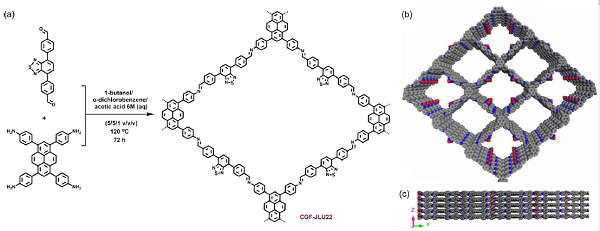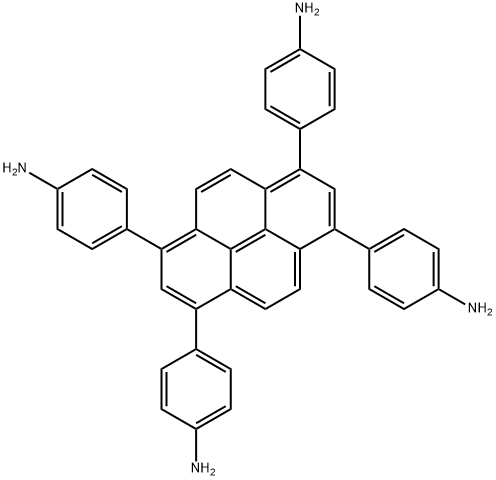What is Benzenamine,4,4',4'',4'''-(1,3,6,8-pyrenetetrayl)tetrakis
Feb 19,2020
Benzenamine,4,4',4'',4'''-(1,3,6,8-pyrenetetrayl)tetrakis is an important organic intermediate (building block) to synthetize covalent organic frameworks (COFs), which are porous long-range ordered materials that have recently attracted considerable scientific attention as candidates for gas storage and separation, catalysis, and as new materials for organic electronics and optoelectronics.

Li et al. reported [1] its application on the synthesis of a predesigned imine-based COF with electron donor and acceptor structure. The new framework possesses large surface area, high crystallinity, outstanding stability and broad absorption range in the visible-light region as well as good photoelectric response characteristics. Importantly, it was found to be a highly effective heterogeneous photocatalyst for reductive dehalogenation of phenacyl bromide derivatives and α-alkylation of aldehydes under irradiation of visible-light. In addition, the COF gave good recyclability and could be reused after a simple separation manipulation.
Gao et al. reported [2] its application on the synthesis of highly photoluminescent imine-based 2D-COFs by integrating a non-planar building unit with a pyrene-based unit and transforming the COF into spherical, sub-micron particles. High photoluminescence quantum yields (PLQY) were achieved with COF sub-micron particles dispersed in organic solvents. The as-prepared COF sub-micron particles can be used as a chemical sensor for the detection of explosive chemicals, with high sensitivity and selectivity (up to ppm level).
Bessinger et al. reported [3] its application on the synthesis of near-infrared-absorbing low bandgap COFs by incorporating donor−acceptor-type isoindigo- and thienoisoindigo-based building blocks. The new materials are intensely colored solids with a high degree of long-range order and a pseudo-quadratic pore geometry. Growing the COF as a vertically oriented thin film allows for the construction of an ordered interdigitated heterojunction through infiltration with a complementary semiconductor. It was found that the spectral response of the device is reversibly switchable between blue- and red-sensitive, and green- and NIR-responsive.This is the first time that such nearly complete inversion of spectral sensitivity of a photodetector has been achieved. This effect could lead to potential applications in information technology orspectral imaging.

References
1. Li Z. et al. Covalent organic framework as an efficient, metal-free, heterogeneous photocatalyst for organic transformations under visible light[J]. Applied Catalysis B: Environmental, 2019, 245:334–342
2. Gao Q. et al. Highly photoluminescent two-dimensional iminebased covalent organic frameworks for chemical sensing[J]. Chem. Commun., 2018, 54:2349--2352
3. Bessinger D. et al. Spectrally Switchable Photodetection with Near-Infrared-Absorbing Covalent Organic Frameworks. J. Am. Chem. Soc. 2017, 139:12035−12042.
- Related articles
- Related Qustion
- 4,4',4'',4'''-(pyrene-1,3,6,8-tetrayl)tetraaniline: properties, applications and safety Nov 23, 2023
4,4',4'',4'''-(Pyrene-1,3,6,8-tetrayl)tetraaniline has exceptional electronic properties, diverse applications, but requires careful handling.
2,2'-Bipyridine-5,5'-dicarboxaldehyde is an important organic intermediate (building block) to synthetize substituted bipyridine products.....
Feb 19,2020Organic Chemistry1,2,4,5-Tetrakis-(4-formylphenyl)benzene is an important organic intermediate to synthetize substituted covalent organic frameworks (COFs)....
Feb 19,2020Organic Chemistry4,4',4'',4'''-(pyrene-1,3,6,8-tetrayl)tetraaniline
1610471-69-6You may like
4,4',4'',4'''-(pyrene-1,3,6,8-tetrayl)tetraaniline manufacturers
- 4,4',4'',4'''-(pyrene-1,3,6,8-tetrayl)tetraaniline
-

- $2.00 / 1KG
- 2020-01-08
- CAS:1610471-69-6
- Min. Order: 1KG
- Purity: 98%
- Supply Ability: 100g , 1kg, 5kg , 50kg




